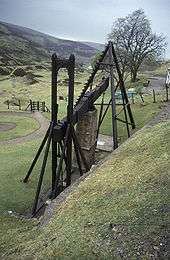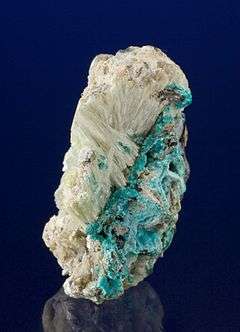Susannite
| Susannite | |
|---|---|
|
Susanite with macphersonite and lanarkite from the Susanna Mine, Leadhills | |
| General | |
| Category | Carbonate minerals |
| Formula (repeating unit) | Pb4SO4(CO3)2(OH)2 |
| Strunz classification | 5.BF.40 |
| Crystal system | Trigonal |
| Crystal class |
Rhombohedral (3) H-M symbol: (3) |
| Space group | R3 |
| Unit cell | a = 9.07, c = 11.57 [Å]; Z = 3 |
| Identification | |
| Color | Colorless, white, pale green, pale yellow, brown |
| Crystal habit | Occurs as equant to acute rhombohedral crystals |
| Cleavage | {0001} perfect |
| Mohs scale hardness | 2.5 - 3 |
| Luster | Adamantine, resinous |
| Diaphaneity | Translucent |
| Specific gravity | 6.55 |
| Optical properties | Uniaxial (anomalously biaxial) |
| Refractive index | 1.96 |
| References | [1][2][3] |
Susannite is a lead sulfate carbonate hydroxide mineral. It has the formula Pb4SO4(CO3)2(OH)2. Susannite is the higher temperature phase of the two and forms above 80 °C when fluids oxidize the lead ore deposits. It is trimorphous with leadhillite and macphersonite.[3]
Susannite crystallizes in the trigonal system. It is quite soft with a Mohs hardness of 2.5 to 3.0 and a relatively high specific gravity of 6.57.

An old beam engine to dewater a lead mine at nearby Wanlockhead
It was discovered in 1827 in the Susannah Mine, Leadhills in the county of Lanark, Scotland.[2] In addition to the type locality in Scotland, it has also been reported from various locations in Germany, the Tiger Mine in Pinal County, Arizona, from Iporanga, Sao Paulo, Brazil, and the Tsumeb mine of Namibia.[3]
See also
References
| Wikimedia Commons has media related to Susannite. |
This article is issued from Wikipedia - version of the 11/25/2016. The text is available under the Creative Commons Attribution/Share Alike but additional terms may apply for the media files.
